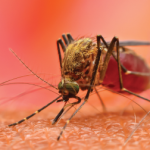The patients, they discovered, had all traveled to Haiti for mission work around the same time earlier that year—in the midst of a major chikungunya outbreak. Of the 10 who eventually tested positive for the virus, eight developed persistent symptoms matching the ACR criteria for seronegative rheumatoid arthritis. “Clinically, until you got that travel history, it looked indistinguishable from a seronegative RA patient who was presenting for the first time,” Dr. Lenschow says.
The uncanny clinical similarities and T cell activation in both diseases, as well as the difficulty in treating some chikungunya patients, prompted a second study to assess the effects of existing disease-modifying anti-rheumatic drugs (DMARDs), in mice. Without a good understanding of how long infectious particles might persist in a patient’s joints, doctors had been wary of trying any DMARDs in human patients. “If we treat them with immunosuppressive drugs, are we going to make the virus grow to higher levels and would the patients do worse?” Dr. Lenschow says. “That set the stage for this study.”
For their initial screen, the team infected mice with the virus, waited three days and then tested eight FDA-approved DMARDs to see whether any might improve or worsen the animals’ acute symptoms. “What we found is that the disease didn’t really get worse with any of the therapies that we tried, and with a couple of the therapies, the disease actually got better,” Dr. Miner says.
In particular, abatacept and tofacitinib significantly reduced joint swelling in the infected mice and decreased the number of immune cells infiltrating the joints. The researchers then looked to see whether either drug in combination with a chikungunya-virus-neutralizing monoclonal antibody might yield more benefits. With the abatacept-antibody combination, Dr. Miner says, “We saw a profound improvement in the arthritis. It almost eliminated the swelling.” Additional tests showed that the dual therapy reduced the cellular infiltrates and the virus replicating in those joints.
Despite the encouraging results, the mechanism underlying the chronic arthritis remains unknown. Research so far has suggested that viral replication is essential; although viral RNA can linger in patients for months, however, infectious viral particles don’t seem to persist as long—at least in the blood. One possibility, Dr. Miner says, is that dead particles and debris may remain in the joints and continue to cause inflammation by activating the host immune response. Alternatively, a remnant virus may continue to replicate within the joints, but fail to produce any infectious particles.

